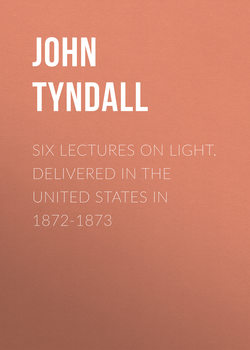Читать книгу Six Lectures on Light. Delivered In The United States In 1872-1873 - John Tyndall - Страница 13
LECTURE II
§ 2. The Emission Theory of Light
ОглавлениеThe case of Newton still more forcibly illustrates the position, that in forming physical theories we draw for our materials upon the world of fact. Before he began to deal with light, he was intimately acquainted with the laws of elastic collision, which all of you have seen more or less perfectly illustrated on a billiard-table. As regards the collision of sensible elastic masses, Newton knew the angle of incidence to be equal to the angle of reflection, and he also knew that experiment, as shown in our last lecture (fig. 3), had established the same law with regard to light. He thus found in his previous knowledge the material for theoretic images. He had only to change the magnitude of conceptions already in his mind to arrive at the Emission Theory of Light. Newton supposed light to consist of elastic particles of inconceivable minuteness, shot out with inconceivable rapidity by luminous bodies. Optical reflection certainly occurred as if light consisted of such particles, and this was Newton's justification for introducing them.
But this is not all. In another important particular, also, Newton's conceptions regarding the nature of light were influenced by his previous knowledge. He had been pondering over the phenomena of gravitation, and had made himself at home amid the operations of this universal power. Perhaps his mind at this time was too freshly and too deeply imbued with these notions to permit of his forming an unfettered judgment regarding the nature of light. Be that as it may, Newton saw in Refraction the result of an attractive force exerted on the light-particles. He carried his conception out with the most severe consistency. Dropping vertically downwards towards the earth's surface, the motion of a body is accelerated as it approaches the earth. Dropping downwards towards a horizontal surface—say from air on to glass or water—the velocity of the light-particles, when they came close to the surface, is, according to Newton, also accelerated. Approaching such a surface obliquely, he supposed the particles, when close to it, to be drawn down upon it, as a projectile is deflected by gravity to the surface of the earth. This deflection was, according to Newton, the refraction seen in our last lecture (fig. 4). Finally, it was supposed that differences of colour might be due to differences in the 'bigness' of the particles. This was the physical theory of light enunciated and defended by Newton; and you will observe that it simply consists in the transference of conceptions, born in the world of the senses, to a subsensible world.
But, though the region of physical theory lies thus behind the world of senses, the verifications of theory occur in that world. Laying the theoretic conception at the root of matters, we determine by deduction what are the phenomena which must of necessity grow out of this root. If the phenomena thus deduced agree with those of the actual world, it is a presumption in favour of the theory. If, as new classes of phenomena arise, they also are found to harmonise with theoretic deduction, the presumption becomes still stronger. If, finally, the theory confers prophetic vision upon the investigator, enabling him to predict the occurrence of phenomena which have never yet been seen, and if those predictions be found on trial to be rigidly correct, the persuasion of the truth of the theory becomes overpowering.
Thus working backwards from a limited number of phenomena, the human mind, by its own expansive force, reaches a conception which covers them all. There is no more wonderful performance of the intellect than this; but we can render no account of it. Like the scriptural gift of the Spirit, no man can tell whence it cometh. The passage from fact to principle is sometimes slow, sometimes rapid, and at all times a source of intellectual joy. When rapid, the pleasure is concentrated, and becomes a kind of ecstasy or intoxication. To any one who has experienced this pleasure, even in a moderate degree, the action of Archimedes when he quitted the bath, and ran naked, crying 'Eureka!' through the streets of Syracuse, becomes intelligible.
How, then, did it fare with the Emission Theory when the deductions from it were brought face to face with natural phenomena? Tested by experiment, it was found competent to explain many facts, and with transcendent ingenuity its author sought to make it account for all. He so far succeeded, that men so celebrated as Laplace and Malus, who lived till 1812, and Biot and Brewster, who lived till our own time, were found among his disciples.
